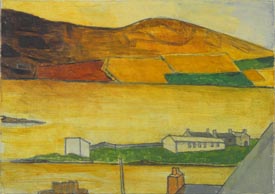Wilhelmina Barns-Graham, known as Willie, was born in St Andrews, Fife, on 8 June 1912. As a child she showed very early signs of creative ability. Determining while at school that she wanted to be an artist, she set her sights on Edinburgh College of Art where, after some dispute with her father, she enrolled in 1931, and after periods of illness, from which she graduated with her diploma in 1937.
At the suggestion of the College’s Principal Hubert Wellington, she moved to St Ives, Cornwall, in 1940, near to where a group of Hampstead-based modernists had settled, at Carbis Bay, to escape the war.This was a pivotal moment in her life. Early on she met Borlase Smart, Alfred Wallis and Bernard Leach, as well as the painter Ben Nicholson and the sculptors Barbara Hepworth and Naum Gabo.
Barns-Graham became a member of the Newlyn Society of Artists and the St Ives Society of Artists but was to leave the latter when, in 1949, the St Ives art community suffered an acrimonious split, and she became a founder member of a breakaway group of abstract artists, the Penwith Society of Arts. She was also one of the initial exhibitors of the significant Crypt Group.
She travelled regularly over the next 20 years to Switzerland, Italy, Paris, and Spain. With the exception of a short teaching term at Leeds School of Art (1956–1957) and three years in London (1960–1963), she lived and worked in St Ives. From 1960, on inheriting a house outside St Andrews from her aunt Mary Niesh (who had been a support to her throughout her art college years), she split her time between summers in Cornwall and winters in Scotland.
Post-war, when St Ives had ceased to be a pivotal centre of modernism, her work and importance as an artist was sidelined, in part by an art-historical consensus that she had been only as a minor member of the St Ives school. In 1999 she was elected an honorary member of the Royal Scottish Academy and the Royal Scottish Watercolourists.
Wilhelmina Barns-Graham died in St Andrews on 26 January 2004. She bequeathed her entire estate to The Barns-Graham Charitable Trust, which she had established in 1987. The aims of the trust are to foster and protect her reputation, to advance the knowledge of her life and work, to create an archive of key works of art and papers, and, in a cause close to her heart, to support and inspire art and art history students through offering grants and bursaries to those in selected art college and universities. Information about the trust and its activities is to be found at http://www.barns-grahamtrust.org.uk

